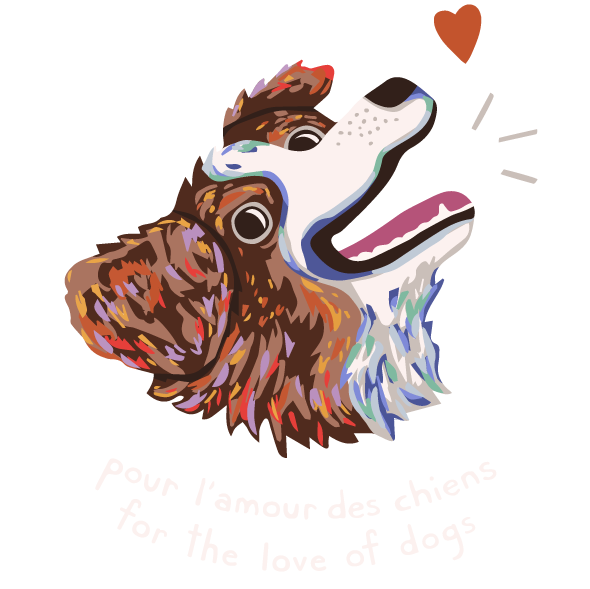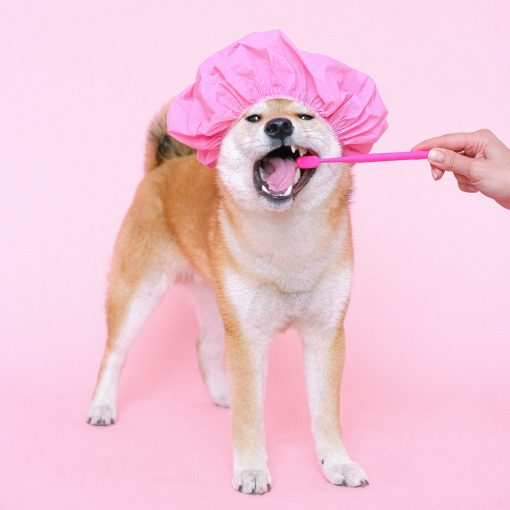Would you like your vet visit to be pleasant and easy? Is your dog uncomfortable or does he have white coat syndrome? (yes this term is also used for dogs!) If so, this article is for you! Below we discuss what to practice to have your dog enjoy the clinic, be able to be calm both waiting for their appointment and during as well as getting them ready for possibly uncomfortable veterinary contentions.

Before your appointment
Make frequent visits to the vet just to get treats. Have you ever tried to walk by your local pet store without your dog trying to drag you inside? Food is a great way to make positive connections for your dog. It turns the vet into a happy place and we promise the receptionists and techs love to see you come in!
If your dog has had other experiences at the vet that have been negative, your vet staff may ask you to muzzle your dog. If this is the case, it’s important to teach this behaviour ahead of time. This helps relieve possible added stress to your dog (and keeps everyone at the clinic safe). Depending on your dog’s level of stress, be aware that there is medication which can help your dog to be calm. Please speak with your clinic prior to your exam if you think your dog could benefit from this.
A note on muzzles: Muzzles get bad press. We think only “aggressive” dogs wear them, but that’s not the case. Dogs who wear muzzles in public most often do so because they’re scared. People use the muzzle as a safety measure alongside other training and tools (like a leash!). The muzzle is there when training and other tools fail. Often, my customers whose dogs wear muzzles in public spaces think that if people were more respectful, their dog wouldn’t need to wear a muzzle, and they’re right. The muzzle is there in case someone reaches down and strokes the dog without asking while the owner’s head is turned (please never do this), or in case an off-leash dog enters directly into their dog’s space. In fact, dogs wear muzzles to protect people and other dogs, but mainly to protect themselves from people who place them in inappropriate situations.
There are a LOT of other reasons why dogs wear muzzles: they eat poop (remember, dogs are coprophagous), they pick up anything outside and swallow it, they’re afraid of other dogs, in order to ride the Montreal metro, they’re afraid of the vet, they’re afraid of the groomer etc.
The truth is that in general, animals and restraints don’t mix. We need to teach them (slowly) that the procedures that need to be carried out and that may require muzzling won’t kill them. I can tell you that I’ve seen very few dogs who haven’t reacted negatively initially to having a muzzle put on their face. Most of my customers come to me when their dog is already hiding behind the sofa at the sight of the muzzle. Consider training this before your dog has a negative association.
Here’s how: https://pourlamourdeschiens.com/en/2023/10/17/muzzle-training-why-and-how/ (written steps)
Video Part 1 https://www.facebook.com/reel/253557107266066
Video Part 2 https://www.facebook.com/reel/226194940214675
Mia looking stylish for the Metro.
Before (and during!) your appointment
Many dogs have to learn to be calm or self regulate in different contexts. We teach this by doing what is called “paying for calm”. This is also very useful for those evenings (certainly those of your with adolescent dogs) we want to get our dog used to being calm on the floor while we watch TV:
- Put your dog on a leash.
- Start to give them treats.
- Start by giving several in a row and wait to see what they do.
- It is important in this exercise to meet the dog where they are in their level of energy. You may want your dog to self-regulate into being able to lie down, but maybe at the moment they are barking and jumping. This means you need to start successively giving them treats until they are in a head space where they are able to start even being able to sit down.
- If they sit, reward this.
- Put a few seconds between rewards and then increase the time.
- If your dog lies down, reward that.
- Continue to reward until you see the dog is calm.
This takes practice, patience and observation. Do not start out your first session thinking you will get 30 minutes training out of your dog. Start with 3 seconds, then 5, 10, 15 etc. then a minute and half, then two, then three and continue from there. Gradually increase the time you put between rewards as well as the time of the training session.
Please remember, food is used to tell the dog: “yes you have done something good, thank you” but is it also used to change an emotion. Food helps a dog calm down and focus on you when maybe they would ordinarily be focused on something else.
Try using a more boring treat for this exercise when you are in an environment with a low level of distraction (your living room when it is quiet). The idea is not to use something that will increase the dog’s level of excitement. However, if you start to increase distraction and your distance from your dog, (like if you take the exercise outside or have guests over) maybe you will need to use something more interesting.
Just before your appointment
Burn their energy by tiring them physically and mentally. Canine enrichment (mental stimulation) is a term used to describe activities that help stimulate and enrich the mental life of your dog. It can involve providing interactive meals, good things to chew or of course training! Don’t forget to practice some basic obedience, new or old tricks, use your dog’s nose to play some scent games or practice any sport you love to do together. Any and all of these activities will make it easier for your dog to be calm during the visit.
Also please don’t forget, even though your vet has treats at their office, you know your best: BRING DELICIOUS TREATS WITH YOU! I personally bring roasted chicken, cheese (low fat!), dried liver and sometimes steak. Why? Because my dog is nervous and having delicious food will help keep them interested in me so my vet can quickly and safely give my dog his injections. Be proactive and come prepared so your dog can have a less stressful (and maybe fun!) experience.
Be proactive and come prepared so your dog can have a less stressful (and maybe fun!) experience. For any help with training for vet visits to be less stressful, please contact us.
Carolyne Baker
Intervenant en Éducation Canine, TA
Pour l’Amour des Chiens/For the Love of Dogs




